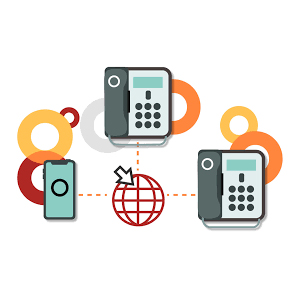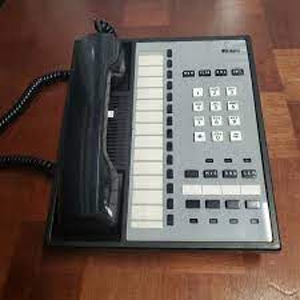Clear and consistent communication is essential to successful business operations. However, finding a phone system that seamlessly integrates with existing business tools and provides a range of features can be complex. Traditionally, multi-line business phone systems run over traditional landlines and require on-site hardware to install and maintain. These systems usually provide auto-attendant, visual voicemail, and call-routing services. This comprehensive guide describes everything you actually need to know about the types of business phones.
Key System Unit (KSU)

The Key System Unit (KSU) is the simplest and usually the most budget-friendly option among all the types of business phones. It employs a central switching device, the KSU, to manually route calls through specific lines, making it ideal for small businesses with budget constraints. It also offers all the essential features small businesses need, such as on-hold, speakerphone, and intercom capabilities.
Most KSU-based phone systems display flashing lights on each key set to indicate available incoming lines. When a call comes in, the KSU senses this and automatically turns the flashing line status light to solid when the user picks up the handset. The user can then select the desired line for the incoming call by viewing the tubes on their key set. Once a call is on hold, the depressed line button mechanically releases, and the KSU will turn off the display of available lines.
Another option for small businesses is the private branch exchange or PBX. A PBX system is more modern than a KSU and lets employees share business lines among internally installed phones. It can connect other office equipment, such as fax machines and modems. Unlike a KSU, however, a PBX doesn’t require a central switching device, making it less vulnerable to system failure.
A more advanced alternative to traditional PBX is VoIP PBX, which utilizes a broadband connection. These types of business phones systems can be cloud-hosted or on-premises and are typically more cost effective than traditional PBX systems. They also offer more flexibility, as they can be moved and transferred to new locations as a business grows. To utilize a VoIP PBX system, a company must have a reliable Internet connection and a compatible VoIP provider. If you’re interested in exploring your new business phone system options, contact Lantel today to schedule an evaluation and receive a free quote.
Read More: QUICKBOOKS DATA MIGRATION FOR BUSINESS GROWTH
KSU-less

The KSU-less system offers an excellent solution for companies with fewer employees and less than ten internal phone lines. This business telephone system is easy to install, portable, and can be used in other locations. However, it lacks certain features that other business phone systems have, such as call tracking and voicemail. To choose the best among all the types of phones, a business must grasp its requirements and how a specific system will operate.
The switching equipment in the KSU-less system is built into the master handset, which allows for more space and flexibility. This system is unsuitable for a company that plans to expand its workforce because it only provides a limited number of internal extensions and does not offer any voicemail or call tracking.
The KSU-less system has a drawback: it’s susceptible to crosstalk, where separate conversations overlap, often due to interference between the master handset and its connected phone line. This can lead to a number of issues, such as missed calls and misunderstandings.
To make sure that the KSU-less system is working correctly, a professional should check it. This will ensure that the system is running smoothly and that the switching equipment in the master handset is functioning correctly. A professional can also provide guidance and support on any technical issues.
Once a business has grown beyond the capabilities of the basic KSU and KSU-less systems, it will need to opt for a Private Branch Exchange (PBX) system. This system is more advanced than the other two, using programmable switching devices to route incoming calls automatically. It is a more expensive option but can be more cost-effective for businesses that want to save money on maintenance and support costs.
A PBX system needs telephone lines and handsets from a service provider aside from the switching hardware. When selecting a plan, it’s vital to consider these requirements, as they impact costs and feature options.
Read More: WORKFORCE SOFTWARE MONDAY | BOOST YOUR BUSINESS
Private Branch Exchange (PBX)

A PBX system connects multiple phones, faxes, and other communication devices within your business. It lets employees connect to the outside world via the Public Switched Telephone Network (PSTN) over traditional copper wires or VoIP channels like Voice over Internet Protocol (VoIP).
In the past, these landline systems required a human operator to connect between extensions manually. Today, these systems automatically connect to external callers using voice-over IP and ISDN communication channels. These systems can also play a recorded greeting for inbound callers, transfer calls, and queue callers until someone is available to answer.
PBX phone systems are available as hosted solutions for the cloud and on-premises hardware, which makes them more flexible than their analog predecessors. A centralized phone system helps businesses increase productivity and provide a professional voice for their customers. The type of PBX your business uses depends on the size and complexity of its phone system.
Analog PBX systems are an option for large businesses that require many lines. They can accommodate up to 100 users and require additional copper telephone landlines and other telephony equipment. This solution has pros and cons, including a high upfront cost, installation, and maintenance fees. Additionally, it only provides essential telephony services and may need to be more adequate for modern-day businesses that need features like multimedia services, voicemail, and conference calling.
A VoIP PBX system offers many advantages for small and midsize companies, such as low startup costs, flexibility, and ease of use. It’s also a cost-effective alternative to traditional business phone systems that support VoIP calls over the Internet. A cloud-based VoIP PBX can be integrated with other office applications, such as instant messaging and videoconferencing software.
Rugged phones are desk-based office phones, while softphones are mobile apps that connect to a business’s PBX system. Softphones offer better call quality than regular smartphones but don’t match the integrations and flexibility of a cloud-based PBX.
VoIP

VoIP, or Voice over Internet Protocol, replaces traditional phone service using the Internet to communicate. It’s one of the newest innovations in business phone systems, and it allows users to block specific calls from callers with landline numbers, cell phone numbers, VoIP numbers, or non-fixed VoIP numbers (number blocks that don’t need a physical address). It also allows businesses to use business phones on desktop computers, mobile devices, or a combination.
As the world embraces new technological advancements, employees demand more flexibility in their work and life. The rise of remote and hybrid work drives the need for better-unified communications. With this, it’s crucial to implement the correct type of phone system in your business.
In addition to its affordability and scalability, VoIP offers features like simultaneous ringing and enhanced voicemail. Additionally, it allows employees to answer incoming calls on any device connected to their VoIP number, and the system can route calls to different locations based on the time of day, user availability, or other criteria.
PBX, or Private Branch Exchange, is another option that’s similar to VoIP but generally requires connections to local telephone networks. A PBX can manage large enterprises’ extensive call requirements, including internal and external calls. It’s also highly customizable and can offer advanced features, including auto attendants and videoconferencing capabilities.
You can install a PBX on-site or choose a hosted PBX system managed by the provider. The hosted option often includes benefits such as email, messaging, videoconferencing, and more to boost communication and productivity.
Hosted PBX systems can also reduce your costs. They eliminate the need for expensive hardware and infrastructure, and you can scale your PBX according to your company’s current and future communication needs.